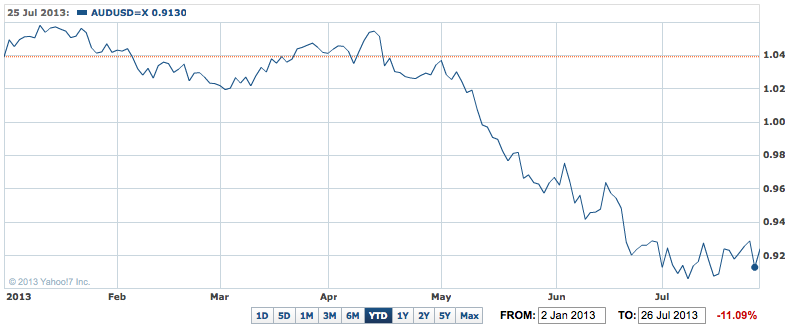The US Federal Reserve and a full week of data on the health of the American economy will dominate markets around the world this week – with a real chance investors could see a repeat of some of the instability seen in June as the central bank moves closer to starting to slow its extraordinary spending on buying bonds and mortgage securities.
While the central bank isn’t expected to start tapering or slowing the rate of its spending (currently $US85 billion a month) at this week’s meeting (September is still the best estimate), the post-meeting statement will contain the central bank’s latest thinking on the fate of its quantitative easing.
Remember that in both May and June, when Fed chairman Ben Bernanke discussed the timing of the start to the slowing of the current spending round, bond yields soared, shares fell (by 6% in late May and early June alone in the US) and commodity prices tanked – led by gold.
Comex December and August gold prices rose 2.2% last week and finished around $US1,321 in trading on Friday night. That’s up substantially from the lows of June.
The yield on 10 year US Government bonds is the best indicator of market thinking of the Fed’s next move. It eased 1 basis point on Friday to 2.56%, up 0.07% over the week and a full 1% (100 points) higher since early May and before Mr Bernanke startled the markets with his comments on easing on May 22.
AUDUSD YTD – Fed to put more pressure on markets this week, starting with the Aussie

But while the Fed meets on Tuesday and Wednesday nights, our time, two other pieces of data – the first estimate of second quarter growth and the July jobs report on Friday – will be out this week and will inform the Fed’s future decision making.
The first estimate of US GDP growth will be out on Wednesday, hours before the Fed’s end of meeting statement and will show an economy slowing. But the growth estimate in this report is usually changed (up or down) in the second estimate released in a month’s time. That’s because more data becomes available on spending and exports.
But growth will be around 1.1% annual or 0.3% quarter on quarter. That will be down from the 1.8% first quarter estimate, but above the 0.4% annual rate in the final quarter of 2012.
Watch out for significant revisions to past quarterly GDP data and most recent – the upshot will be a bigger economy and perhaps faster growing.
And on Friday the US jobs report for July is not expected to provide much in the way of clarity for the Fed’s thinking because market forecasts suggest little change in the unemployment rate of around 7.6% (perhaps down to 7.5%).
A Reuters poll says around 185,000 jobs might have been created in july, compared with 195,000 in June. But as is now commonplace with these reports, there will be extensive revisions of previous months’ data that could boost or weaken the overall tone of the report.
The employment picture is important because the Fed has set an unemployment rate of 6.5% as the benchmark where it will look at ending the current round of easing. That is still expected to be reached late in 2014.
So whatever the Fed says this week, the easing spending will continue for more than a year – it is just the level that is being debated.
Some analysts wrongly claim that cutting the Fed’s rate of spending will be the same as tightening monetary policy – it won’t because the Fed will still keep interest rates at their current low of 0%-0.25% for several more years.
Being both the end of the month and the start, there is also a host of other figures for the markets to digest – these include the final consumer confidence reports for July, pending home sales and home price data (the important Case Schiller Index), the monthly manufacturing survey, car sales for July and a monthly survey on the health of manufacturing in the midwest of the US.
The next Fed meeting after this week is in mid September (around the 17th of the month).













